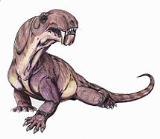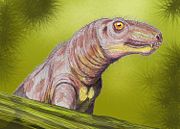
Biarmosuchia
Encyclopedia
Biarmosuchia, also known as Eotitanosuchia and Phthinosuchia, is an assemblage of primitive Permian
therapsids
that represent either a paraphyletic stem group or a very early off-shoot of the main therapsid tree.
They were moderately sized, lightly built carnivores, intermediate in form between the sphenacodont
pelycosaur
s and more advanced therapsids.
 The biarmosuchian skull
The biarmosuchian skull
is very similar to the sphenacodont skull, differing only in the larger temporal fenestra (although these are still small relative to later therapsids), slightly backward-sloping occiput
(the reverse of the pelycosaur condition), reduced number of teeth, and single large canine teeth in both upper and lower jaws, and other features (Carroll 1988 pp.370, Benton 2000 p.114). In later specialised Biarmosuchia, these resemble the enlarged canines of the Gorgonopsia
. The presence of larger jaw-closing muscles (and hence a stronger bite), as indicated by the flaring of the rear of the skull where these muscles were attached.
The vertebrae are also sphenacodontid-like (but lack the long neural spines that distinguish Dimetrodon
and its kin), but the shoulder and pelvic girdles and the limbs indicate a much more advanced posture. The feet are more symmetrical, indicating that they faced forward throughout the stride, and the phalanges (toes) are reduced in length so that they are more like that of later synapsids (therapsids and mammals) (Carroll 1988 pp.370-1).
(Phthinosuchus
, Biarmosuchus
, Eotitanosuchus
) and the South African (Ictidorhinidae, Burnetiidae
, and associated forms), and is totally restricted to the Middle and Late Permian

 Hopson and Barghusen (1986 p.88) tentatively united Biarmosuchidae and Ictidorhinidae (including Hipposauridae and Rubidginidae) as "Biarmosuchia", but were undecided as to whether they constituted a natural group or an assemblage that had in common only shared primitive characteristics. They thought Phthinosuchus too poorly known to tell if it also belonged, but considered Eotitanosuchus a more advanced form.
Hopson and Barghusen (1986 p.88) tentatively united Biarmosuchidae and Ictidorhinidae (including Hipposauridae and Rubidginidae) as "Biarmosuchia", but were undecided as to whether they constituted a natural group or an assemblage that had in common only shared primitive characteristics. They thought Phthinosuchus too poorly known to tell if it also belonged, but considered Eotitanosuchus a more advanced form.
Sigogneau-Russell (1989) erected the infraorder Biarmosuchia to include the families Biarmosuchidae, Hipposauridae and Ictidorhinidae, distinct from Eotitanosuchia and Phthinosuchia.
Ivakhnenko (1999) argued that Biarmosuchus tener, Eotitanosuchus olsoni, and Ivantosaurus ensifer, all known from the Ezhovo locality, Ocher Faunal Assemblage, are actually the same species. Even if these taxa are shown to be distinct, Ivakhnenko's paper indicates that Eotitanosuchus and Biarmosuchus are very similar animals. Ivakhnenko also relocates the family Eotitanosuchidae to the order Titanosuchia, superorder Dinocephalia
.
Benton 2000 and 2004 gives the Biarmosuchia the rank of suborder.
Permian
The PermianThe term "Permian" was introduced into geology in 1841 by Sir Sir R. I. Murchison, president of the Geological Society of London, who identified typical strata in extensive Russian explorations undertaken with Edouard de Verneuil; Murchison asserted in 1841 that he named his "Permian...
therapsids
Therapsida
Therapsida is a group of the most advanced synapsids, and include the ancestors of mammals. Many of the traits today seen as unique to mammals had their origin within early therapsids, including hair, lactation, and an erect posture. The earliest fossil attributed to Therapsida is believed to be...
that represent either a paraphyletic stem group or a very early off-shoot of the main therapsid tree.
They were moderately sized, lightly built carnivores, intermediate in form between the sphenacodont
Sphenacodontidae
Sphenacodontidae is a family of small to large, advanced, carnivorous, Late Pennsylvanian to middle Permian pelycosaurs. Primitive forms were generally small in size , but during the later part of the early Permian these animals grew progressively larger , to become the top predators of their...
pelycosaur
Pelycosaur
The pelycosaurs are an informal grouping composed of basal or primitive Late Paleozoic synapsid amniotes. Some species were quite large and could grow up to 3 meters or more, although most species were much smaller...
s and more advanced therapsids.
Characteristics

Skull
The skull is a bony structure in the head of many animals that supports the structures of the face and forms a cavity for the brain.The skull is composed of two parts: the cranium and the mandible. A skull without a mandible is only a cranium. Animals that have skulls are called craniates...
is very similar to the sphenacodont skull, differing only in the larger temporal fenestra (although these are still small relative to later therapsids), slightly backward-sloping occiput
Occiput
The occiput is the anatomical term for the posterior portion of the head, in insects the posterior part of those head capsule.-Clinical significance:Trauma to the occiput can cause a basilar skull fracture....
(the reverse of the pelycosaur condition), reduced number of teeth, and single large canine teeth in both upper and lower jaws, and other features (Carroll 1988 pp.370, Benton 2000 p.114). In later specialised Biarmosuchia, these resemble the enlarged canines of the Gorgonopsia
Gorgonopsia
Gorgonopsia is a suborder of therapsid synapsids. Their name is a reference to the Gorgons of Greek mythology. Like other therapsids, gorgonopsians were at one time called "mammal-like reptiles"...
. The presence of larger jaw-closing muscles (and hence a stronger bite), as indicated by the flaring of the rear of the skull where these muscles were attached.
The vertebrae are also sphenacodontid-like (but lack the long neural spines that distinguish Dimetrodon
Dimetrodon
Dimetrodon was a predatory synapsid genus that flourished during the Permian period, living between 280–265 million years ago ....
and its kin), but the shoulder and pelvic girdles and the limbs indicate a much more advanced posture. The feet are more symmetrical, indicating that they faced forward throughout the stride, and the phalanges (toes) are reduced in length so that they are more like that of later synapsids (therapsids and mammals) (Carroll 1988 pp.370-1).
Distribution
Biarmosuchia is known from both RussiaRussia
Russia or , officially known as both Russia and the Russian Federation , is a country in northern Eurasia. It is a federal semi-presidential republic, comprising 83 federal subjects...
(Phthinosuchus
Phthinosuchus
Phthinosuchus was a therapsid that lived in the Late Permian of Russia. Phthinosuchus is the sole member of its family and suborder, although Phthinosaurus may be a relative...
, Biarmosuchus
Biarmosuchus
Biarmosuchus tener was a therapsid that lived around 255 mya during the late Permian period. It was discovered in the Perm region of Russia. The specimen was found in channel sandstone that was deposited by flood waters originating from the young Ural mountains. The species is the most primitive of...
, Eotitanosuchus
Eotitanosuchus
Eotitanosuchus olsoni is a mammal-like reptile whose fossils were found in the town of Ochyor in Perm Krai, Russia, in channel flood deposits along with Biarmosuchus tener, Estemmenosuchus uralensis and Estemmenosuchus mirabilis.It lived about 255 mya and was a very large animal; although the...
) and the South African (Ictidorhinidae, Burnetiidae
Burnetiidae
The Burnetiids were a family belonging to the Biarmosuchian clade that lived in the Permian Period. This family contains Bullacephalus, Burnetia, Lemurosaurus, Lobalopex, Niuksenitia, Paraburnetia and Proburnetia....
, and associated forms), and is totally restricted to the Middle and Late Permian
Permian
The PermianThe term "Permian" was introduced into geology in 1841 by Sir Sir R. I. Murchison, president of the Geological Society of London, who identified typical strata in extensive Russian explorations undertaken with Edouard de Verneuil; Murchison asserted in 1841 that he named his "Permian...
Taxonomic history


Sigogneau-Russell (1989) erected the infraorder Biarmosuchia to include the families Biarmosuchidae, Hipposauridae and Ictidorhinidae, distinct from Eotitanosuchia and Phthinosuchia.
Ivakhnenko (1999) argued that Biarmosuchus tener, Eotitanosuchus olsoni, and Ivantosaurus ensifer, all known from the Ezhovo locality, Ocher Faunal Assemblage, are actually the same species. Even if these taxa are shown to be distinct, Ivakhnenko's paper indicates that Eotitanosuchus and Biarmosuchus are very similar animals. Ivakhnenko also relocates the family Eotitanosuchidae to the order Titanosuchia, superorder Dinocephalia
Dinocephalia
Dinocephalia are a clade of large early therapsids that flourished during the Middle Permian, but became extinct leaving no descendants.-Description:...
.
Benton 2000 and 2004 gives the Biarmosuchia the rank of suborder.
External links
- Therapsida: Biarmosuchia at Palaeos

